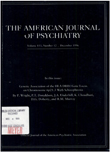Quantitative morphology of the corpus callosum in attention deficit hyperactivity disorder
Abstract
OBJECTIVE: By means of quantitative neuroanatomic imaging the authors assessed the hypothesis that there are structural brain abnormalities relevant to frontal lobe circuitry in children with attention deficit hyperactivity disorder (ADHD). METHOD: The midsagittal cross-sectional area of the corpus callosum, divided into seven sections, was measured from magnetic resonance images of 18 boys with ADHD and 18 carefully matched normal boys. RESULTS: Two anterior regions, the rostrum and the rostral body, were found to have significantly smaller areas in the ADHD group. These areas correlated in the expected direction with teacher and parent ratings of hyperactivity/impulsivity. CONCLUSIONS: This finding supports theories of abnormal frontal lobe development and function in ADHD.
Access content
To read the fulltext, please use one of the options below to sign in or purchase access.- Personal login
- Institutional Login
- Sign in via OpenAthens
- Register for access
-
Please login/register if you wish to pair your device and check access availability.
Not a subscriber?
PsychiatryOnline subscription options offer access to the DSM-5 library, books, journals, CME, and patient resources. This all-in-one virtual library provides psychiatrists and mental health professionals with key resources for diagnosis, treatment, research, and professional development.
Need more help? PsychiatryOnline Customer Service may be reached by emailing [email protected] or by calling 800-368-5777 (in the U.S.) or 703-907-7322 (outside the U.S.).



